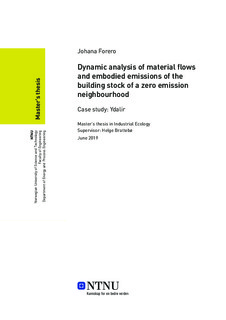| dc.description.abstract | The bottom-up approach model developed earlier by Næss et al. (2018) is extended to include the dynamic material flow and embodied emissions from materials during con- struction, renovation and demolition activities of a neighbourhood in time. The model is then applied to the ZEN pilot project Ydalir in order to estimate the material flows and the associated embodied emissions of the building stock of the neighbourhood for a 60 years timeframe.
In order to achieve that, the model is made up of three parts that consist of: (i) sim- ulating the long-term building stock of the neighbourhood and identifying construction, renovation and demolition over time, (ii) setting up the material inventories that charac- terize the building stock and determining the emission intensities of those materials, (iii) combining (i) and (ii) to calculate the dynamic material use and embodied emissions for the neighbourhood over time. The neighbourhood is characterized by 15 initial individual archetypes according to type of building, renovation stage and cohort.
The dynamic model of Ydalir indicates that construction and renovation activities mobilize a total of 116 kton of materials with 82.6 kton CO2-eq of embodied emissions between 2019 and 2080. Initial construction being the activity that drives most use of materials and embodied emissions. The major source of embodied emissions are the PV panels that are part of the energy system in the residential buildings, this is due to the high carbon intensity of the system but also its need to be replaced every 30 years. Wood is the second most used material in the neighbourhood, as well as the second most accountable for the neighbourhood’s embodied emissions. In terms of material flow, concrete is the dominant material, more than half of the material input to the neighbourhood is concrete.
The sensitivity analysis suggests that variations in renovation rates, material invento- ries and emission intensities of materials have an effect in the total embodied emissions, with room to reduce embodied emissions. Additionally, the material specifications and emission intensities that are selected in the material categories of concrete, wood, glass and membrane can have a greater impact in the total embodied emissions for the case of Ydalir.
The model is robust because its methodology is thorough, transparent and detailed, yet, the assumptions made and lack of knowledge about the future limit the certainty and accuracy of of the results for Ydalir. Nevertheless, some strategies related to embodied emissions and material flow of the building stock of a neighbourhoods are identified. For instance, using threshold values for the embodied emission intensity of the building stock of a neighbourhood could be implemented as a guideline to design the neighbourhood and control the embodied emissions from the building stock. | |
